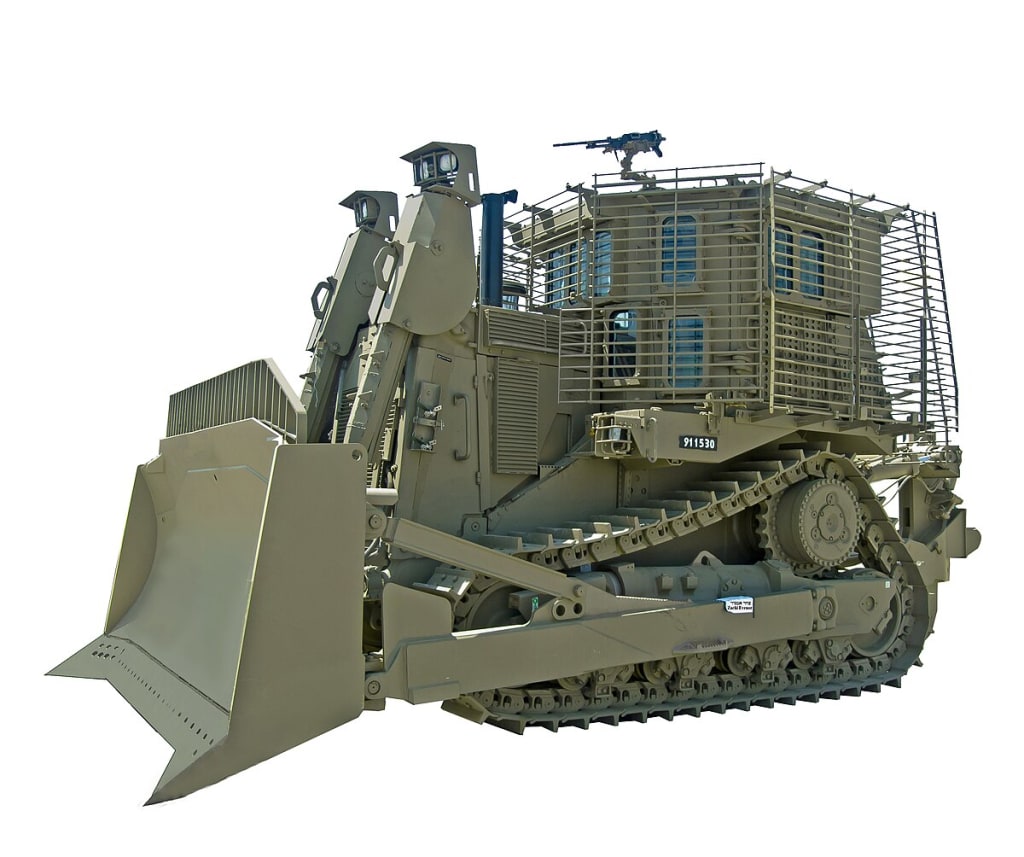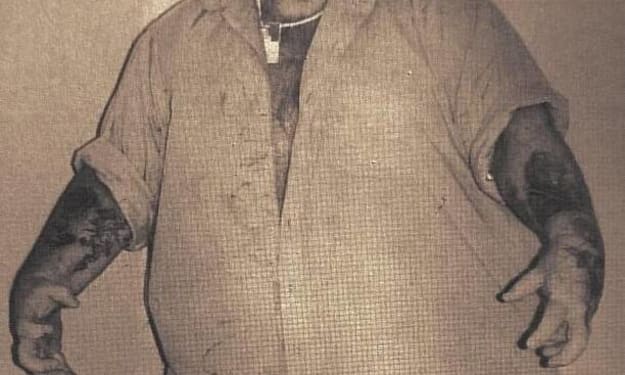Israel's D9 Caterpillar, a remarkable piece of machinery!
Military's Equipment

The caterpillar D9 bulldozer, a prominent figure in the Israeli Defense Forces, possesses a remarkable tale of military transformation. In addition to its regular civilian tasks, this machine has been adapted for tactical purposes on the battlefield. The IDF's utilization of this monstrous vehicle for covert operations remains shrouded in secrecy. The caterpillar D9 bulldozer, renowned for its sheer power, already possesses an intimidating presence even before Israel incorporates its own customizations. The specific models procured by Israel, however, are classified as State Secrets, leaving the exact details undisclosed.
For the purpose of this article, let's assume that Israel purchases D9 bulldozers from Caterpillar with all the available features and accessories. Now, let's delve into the basic measurements of this massive machine. From the front of the blade tip to the back of the Ripper at the rear of the vehicle, the D9 has an overall length of nearly 27 feet. It stands at approximately 12 and a half feet tall, from the bottom of the tracks to the top of the exhaust stack. The width of the D9 is just under 9 and a half feet, measured from track to track. Apart from its substantial size, the D9 is also quite heavy.
According to Caterpillar's standard models, without any additional components or contents, it weighs slightly over 42 tons. However, when equipped with a blade, a ripper, 254 gallons of fuel, 24 gallons of hydraulic fluid, refrigeration coolant, a rollover protection system, and the operator, the weight of the standard model increases to 55 tons. Of course, the weight further increases due to Israel's installation of various armor packages. Once the standard models are received in Israel, the military begins the process of converting these civilian vehicles into weapons of war.
The primary method of doing so is by adding heavy armor plating to all parts of the vehicle, including the undercarriage. While the exact dimensions of this armor package are unknown, it is estimated to add approximately 15 tons of extra weight.
Israel has also implemented the addition of armored plates to enhance protection for the cockpit, known as the cabin, against tandem charge Warheads such as RPGs and anti-tank missiles. These upgrades have significantly increased the weight of the vehicle to an impressive 70 tons, placing it on par with Israel's main battle tank, the Marava, which weighs approximately 65 tons before being loaded with fuel, ammunition, and personnel.
In addition to the armor enhancements, Israel has incorporated an extra seat in the cockpit, allowing for a vehicle commander. Some modified D9s have also been equipped with a heavy machine gun, grenade launchers, and smoke launchers to provide additional defensive capabilities. Considering the size and weight of this vehicle, it undoubtedly requires a powerful engine. The D9 is powered by a Cat C18 6-cylinder diesel engine, generating an output of 452 horsepower. This results in a power ratio of around 6.5 horsepower per ton, although it falls short of the requirements for a main battle tank.
The heavily armoured bulldozer is truly impressive. Its speed depends on the gear selected by the driver. In forward motion, it can reach a maximum speed of 6.8 mph, while in reverse, it can go up to 8.4 mph. The hydraulic system of the bulldozer allows for the control of various attachments and blades. There are two main blade options for the D9: the semi-universal blade and the universal blade. The universal blade is slightly larger, weighing 6 tons compared to the semi-universal blade's 5 tons. It also has a higher carry capacity of 21.7 cubic yards of material, whereas the semi-universal blade can carry up to 17.8 cubic yards. The universal blade stands at a height of 6.3 ft. and can penetrate the Earth up to 2 ft. per scoop.
At the rear of the bulldozer, the Israeli military can choose from several rippers. These rippers are specifically designed to break through hardened surfaces like concrete and asphalt. The D9 offers three ripper attachments: single shank, multi-shank, and single shank deep ripping. Each attachment has its own unique benefits. The single shank deep ripping component, for instance, can penetrate over 5 1/2 ft. into the Earth with an impressive force of 38,600 ft-lb. With such a powerful attachment, the D9 proves to be an exceptional machine.
The D9 is capable of effortlessly tearing up nearly any material it encounters in the field. In terms of operating the vehicle, the D9 is equipped with various features that prioritize a safe and smooth operation. It comes with its own onboard fire suppression system and can be fitted with 360° cameras. Each of the four cameras provides high-definition video, ensuring clear visibility for the driver. However, it is important to note that the D9 is also quite loud. Therefore, operators must wear robust hearing protection while inside the cockpit to safeguard their hearing and facilitate communication with one another.
Despite its immense power, the D9 has undergone seven decades of trial and error by Israeli forces to reach its current state. It was first introduced in 1954 and has since become a commercial success for the company. While many companies recognized the usefulness of such a heavy bulldozer, the early IDF saw a unique military opportunity. In the mid-1950s, Israel was in the process of establishing its defense industrial base and moving away from World War II hand-me-downs.
The powerful D9 bulldozer presented an opportunity to carry out complex engineering operations with minimal modifications to make it suitable for combat situations. After procuring a few dozen units from Caterpillar, the D9 saw its first combat use during the 1956 Suez Crisis. These bulldozers played a crucial role in clearing paths through minefields and breaching the large earth berms erected by the Egyptian military to defend the Sinai Peninsula. Once the D9s breached the earth berms, other vehicles followed, deploying portable bridges across various waterways and streams that hindered Egyptian troops. Since its initial deployment, the IDF has consistently utilized D9 bulldozers in every conflict.
The D9 has been involved in various military operations throughout its history. It has seen action in significant conflicts such as the Six Day War, the 1973 Yam Kapor War, the 1982 invasion of Lebanon, and the ongoing conflict in Gaza. However, despite its long history, the D9 has undergone several changes and advancements. Over the past 70 years, numerous models have been introduced into the Israeli military. The oldest models still in service are the D9L and the D9N, which have less advanced armor and less powerful engines compared to the modern-day D9R.
The D9 has been used for various purposes, including breaching barriers, towing heavy equipment, and clearing minefields. While these core uses have remained consistent, the Israeli Defense Forces (IDF) have adapted their tactics to address emerging threats on the battlefield. For example, during the 1982 Lebanon war, the D9 bulldozers were used to demolish rigged buildings, minimizing the risk to soldiers' lives. Additionally, during conflicts with Palestinian insurgents, the IDF developed new strategies to effectively combat these threats.
Insurgents often sought refuge in houses and would fight until their demise. In order to minimize collateral damage, Israel opted for air strikes on buildings rather than pounding them. They employed D9 bulldozers to physically demolish houses with insurgents still inside. Over time, the Israeli military has incorporated the use of D9 bulldozers into their battle strategies, particularly in heavily urbanized areas like the Gaza Strip. For instance, during an assault on an orchard, Israeli infantry would first secure the area, and then the D9 bulldozers, under the cover of the infantry, would advance and clear the way by knocking down trees and ploughing the earth with their rippers. This tactic allows the Israeli troops to safely advance through predetermined routes.
Similarly, in tight city streets, if Israeli troops encounter resistance from a fortified position, a D9 bulldozer can be summoned to create a path by demolishing buildings on either side of the street. This enables the Israeli troops to advance through the buildings without being exposed to enemy fire. Additionally, engineering battalions are frequently deployed to destroy Hamas tunnel shafts in the Gaza Strip. Instead of causing extensive collateral damage and unintended explosions by blowing up the tunnels, these bulldozers are used to bury the tunnel entrances with earth, effectively sealing them off. Due to their proven effectiveness on the battlefield, D9 bulldozers have become a staple in Israeli urban combat tactics.
The IDF has made the decision to enhance the capabilities of the D9 by implementing Israel's finest upgrades. One of these upgrades is the Iron Fist active protection system, which is a scaled-down version of the well-known trophy active protection system used on tanks and armored vehicles. The D9's Iron Fist system consists of four main components. The system is equipped with a series of RF and passive infrared sensors, as well as a set of cameras that provide a 360° coverage during both day and night combat operations.
These sensors play a crucial role in detecting the source of Small Arms fire. The system itself has both passive and active measures to neutralize incoming threats. Additionally, the missile launcher is equipped with a built-in Jammer that disrupts signals to remote-controlled IEDs and guided missiles. The main control unit inside the D9 acts as the brain of the system, determining whether an incoming projectile poses a threat and, if so, selecting the appropriate countermeasure. In cases where a hard kill is necessary, the Iron Fist can launch an interceptor missile to destroy the threat before it reaches the Dozer. It is important to note that not all Dozers are currently equipped with this system, as it is primarily installed in the newer d9r versions. However, as hostilities persist in the Gaza Strip, it is likely that more d9s will be equipped with the Iron Fist system.
The d9t variant, an innovative technology, has been in service for several years. It is a fully remote controlled version designed for the most perilous missions that a D9 could encounter. These missions include clearing IED-infested roads or demolishing houses rigged with explosives. The exact number of d9t variants currently in service is unclear, but news reports suggest that the IDF desires a significant quantity of these vehicles as quickly as the industry can produce them for use in Gaza. The history of the D9 has demonstrated its unmatched versatility on the battlefield, and with Israel's ongoing technological advancements, this kill Dozer will continue to be a source of terror for would-be terrorists for generations to come.
About the Creator
Enjoyed the story? Support the Creator.
Subscribe for free to receive all their stories in your feed. You could also pledge your support or give them a one-off tip, letting them know you appreciate their work.






Comments
There are no comments for this story
Be the first to respond and start the conversation.